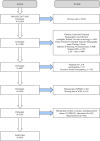Association between Weight-Adjusted Waist Index and Depression in NAFLD: the modulating roles of sex and BMI
- PMID: 39567895
- PMCID: PMC11580667
- DOI: 10.1186/s12888-024-06308-8
Association between Weight-Adjusted Waist Index and Depression in NAFLD: the modulating roles of sex and BMI
Abstract
Background: The Weight-Adjusted Waist Index (WWI) is a novel indicator of obesity that accurately reflects body composition. However, the association between WWI and depression in patients with non-alcoholic fatty liver disease (NAFLD) remains unclear. This study aims to explore this relationship through a nationally representative cross-sectional analysis.
Methods: This study included adult participants diagnosed with NAFLD from NHANES 2017-2020. WWI was calculated as the waist circumference (cm) divided by the square root of body weight (kg). NAFLD diagnosis relied on vibration-controlled transient elastography (VCTE) with a controlled attenuation parameter (CAP) exceeding 248 dB/m to indicate hepatic steatosis. Depression was assessed using the Patient Health Questionnaire-9 (PHQ-9), with scores ≥ 10 indicating the presence of major depression.
Results: After adjusting for all covariates, a significant positive association was found between WWI and depression in NAFLD (OR = 1.725, 95% CI: 1.442-2.063, p < 0.00001), with a dose-response relationship indicated by restricted cubic spline analysis. The association was stronger in men and lean/normal weight NAFLD patients. Adjusting further for BMI did not alter these findings (OR = 1.643, 95% CI: 1.357-1.989, p < 0.00001). BMI's association with depression was negated after adjusting for WWI.
Conclusions: WWI had a positive association with depression in NAFLD, independent of BMI. This association was more pronounced in men and lean/normal weight NAFLD. These findings suggest that WWI may be a novel indicator of depression in NAFLD and potentially valuable in depression prevention.
Keywords: Central obesity; Depression; NHANES; Non-alcoholic fatty liver Disease(NAFLD); Weight-adjusted Waist Index(WWI).
© 2024. The Author(s).
Conflict of interest statement
Declarations. Ethics approval and consent to participate: Not applicable. Consent for publication: Not applicable. Competing interests: The authors declare no competing interests.
Figures




Similar articles
-
Association between weight-adjusted waist index and hepatic steatosis and fibrosis: Analyses of the NHANES 2017 to 2020.Medicine (Baltimore). 2025 Jun 6;104(23):e42708. doi: 10.1097/MD.0000000000042708. Medicine (Baltimore). 2025. PMID: 40489808 Free PMC article.
-
Weight-adjusted waist circumference index with hepatic steatosis and fibrosis in adult females: a cross-sectional, nationally representative study (NHANES 2017-2020).BMC Gastroenterol. 2025 Mar 5;25(1):137. doi: 10.1186/s12876-025-03706-4. BMC Gastroenterol. 2025. PMID: 40045243 Free PMC article.
-
Weight-adjusted waist index is positively and linearly associated with all-cause and cardiovascular mortality in metabolic dysfunction-associated steatotic liver disease: findings from NHANES 1999-2018.Front Endocrinol (Lausanne). 2024 Sep 30;15:1457869. doi: 10.3389/fendo.2024.1457869. eCollection 2024. Front Endocrinol (Lausanne). 2024. PMID: 39403588 Free PMC article.
-
Association between weight-adjusted waist index and non-alcoholic fatty liver disease: a population-based study.BMC Endocr Disord. 2024 Feb 18;24(1):22. doi: 10.1186/s12902-024-01554-z. BMC Endocr Disord. 2024. PMID: 38369482 Free PMC article.
-
Association between Weight-Adjusted Waist Index and depressive symptoms: A nationally representative cross-sectional study from NHANES 2005 to 2018.J Affect Disord. 2024 Apr 1;350:49-57. doi: 10.1016/j.jad.2024.01.104. Epub 2024 Jan 12. J Affect Disord. 2024. PMID: 38220117 Review.
Cited by
-
Association of weight-adjusted waist index with preserved ratio impaired spirometry and all-cause mortality.Front Nutr. 2025 May 20;12:1594453. doi: 10.3389/fnut.2025.1594453. eCollection 2025. Front Nutr. 2025. PMID: 40463466 Free PMC article.
-
Nonlinear Association Between BMI and Depression Among Nonalcoholic Fatty Liver Disease: NHANES (2017-2018).Behav Neurol. 2025 Jul 28;2025:8868665. doi: 10.1155/bn/8868665. eCollection 2025. Behav Neurol. 2025. PMID: 40761708 Free PMC article.
-
Association of lymphocyte-to-C-reactive protein ratio with cerebral small vessel disease: a cross-sectional study based on dose-response analysis.Front Neurol. 2024 Dec 24;15:1480115. doi: 10.3389/fneur.2024.1480115. eCollection 2024. Front Neurol. 2024. PMID: 39777309 Free PMC article.
-
Identification of immune and major depressive disorder-related diagnostic markers for early nonalcoholic fatty liver disease by WGCNA and machine learning.Front Bioinform. 2025 Jun 26;5:1594971. doi: 10.3389/fbinf.2025.1594971. eCollection 2025. Front Bioinform. 2025. PMID: 40689242 Free PMC article.
References
-
- McCarron RM, Shapiro B, Rawles J, Luo J. Depression. Ann Intern Med. 2021;174(5):Itc65-itc80. 10.7326/aitc202105180. - PubMed
-
- Malhi GS, Mann JJ. Depression. Lancet. 2018;392(10161):2299 − 312. 10.1016/s0140-6736(18)31948-2. - PubMed
-
- Cai H, Jin Y, Liu R, Zhang Q, Su Z, Ungvari GS, et al. Global prevalence of depression in older adults: a systematic review and meta-analysis of epidemiological surveys. Asian J Psychiatr. 2023;80:103417. 10.1016/j.ajp.2022.103417. - PubMed
MeSH terms
Grants and funding
LinkOut - more resources
Full Text Sources
Medical
Miscellaneous

